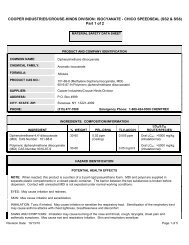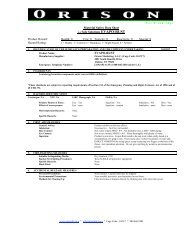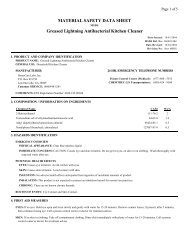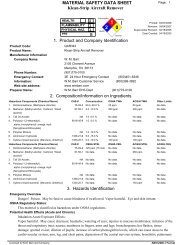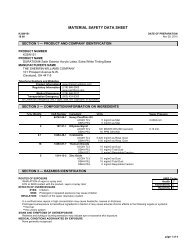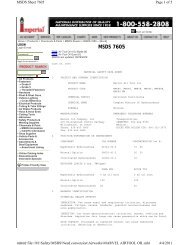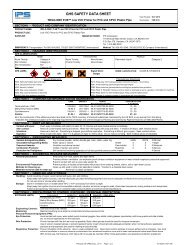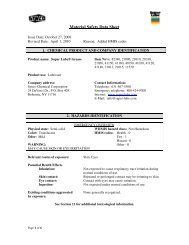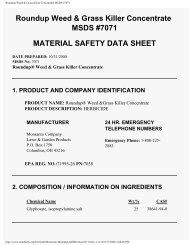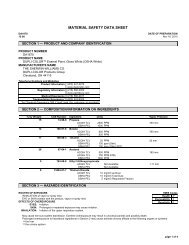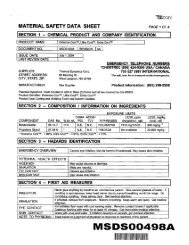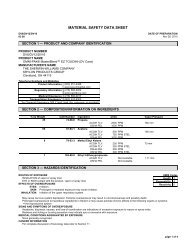MATERIAL SAFETY DATA SHEET - Multi-Craft Contractors, Inc.
MATERIAL SAFETY DATA SHEET - Multi-Craft Contractors, Inc.
MATERIAL SAFETY DATA SHEET - Multi-Craft Contractors, Inc.
You also want an ePaper? Increase the reach of your titles
YUMPU automatically turns print PDFs into web optimized ePapers that Google loves.
11. TOXICOLOGICAL INFORMATION (Continued)<br />
Reproductive Toxicity: This product is not reported to cause reproductive effects in humans. Reproductive toxicity data<br />
are available for Methyl Ethyl Ketone and Tetrahydrofuran (a component of this product); these data were obtained from<br />
clinical studies on test animals exposed to relatively high doses.<br />
A mutagen is a chemical which causes permanent changes to genetic material (DNA) such that the changes will propagate<br />
through generational lines. An embryotoxin is a chemical which causes damage to a developing embryo (i.e. within the first<br />
eight weeks of pregnancy in humans), but the damage does not propagate across generational lines. A teratogen is a<br />
chemical which causes damage to a developing fetus, but the damage does not propagate across generational lines. A<br />
reproductive toxin is any substance which interferes in any way with the reproductive process.<br />
ACGIH BIOLOGICAL EXPOSURE INDICES: Currently, there are ACGIH Biological Exposure Indices (BEIs) associated with<br />
components of this product, as follows:<br />
CHEMICAL DETERMINANT SAMPLING TIME BEI<br />
ACETONE<br />
• Acetone in urine • End of shift • 100 mg/L<br />
METHYL ETHYL KETONE (MEK)<br />
• MEK in urine • End of shift • 2 mg/L<br />
TETRAHYDROFURAN (Intended)<br />
• Tetrahydrofuran in urine • End of shift • 8 mg/L<br />
MEDICAL CONDITIONS AGGRAVATED BY EXPOSURE: Preexisting respiratory problems, dermatitis, and other skin<br />
disorders, as well as conditions involving the “Target Organs” (see Section 3, Hazard Identification) can be aggravated by<br />
exposure to this product.<br />
RECOMMENDATIONS TO PHYSICIANS: Treat symptoms and eliminate overexposure. If necessary, review for brain and<br />
central nervous system effects and conduct pulmonary function test. Other tests for lung, kidney, and liver effects may also<br />
prove useful.<br />
12. ECOLOGICAL INFORMATION<br />
ALL WORK PRACTICES MUST BE AIMED AT ELIMINATING ENVIRONMENTAL CONTAMINATION.<br />
ENVIRONMENTAL STABILITY: The components of this product will biodegrade into other organic compounds.<br />
Environmental data are available for components of this product, as follows:<br />
CYCLOHEXANONE: K OC - 0.81. Water Solubility 23,000 mg/L. Cyclohexanone is not rapidly volatilized from water, except for fast moving streams or very<br />
shallow ponds. Significant soil leaching occurs, contributing to ground water contamination. Biodegradation and photolysis occur in water. Rapid<br />
atmospheric degradation occurs via photolysis, with a half-life of about 1 to 5 days.<br />
METHYL ETHYL KETONE: Log Kow = 0.29. Water Solubility = 239,000 mg/L. Methyl Ethyl Ketone is rapidly volatilized from water and undergoes slow<br />
biodegradation. It undergoes moderate atmospheric photodegradation.<br />
TETRAHYDROFURAN: Water Solubility = 30% (25°C). Tetrahydrofuran is significantly biodegraded in standard tests. This compound is not expected to<br />
bioconcentrate in fish significantly.<br />
EFFECT OF <strong>MATERIAL</strong> ON PLANTS or ANIMALS: This product can be harmful or fatal to contaminated plant or animal life,<br />
especially if released in large quantities into the environment. Refer to Section 11 (Toxicological Information) for information<br />
regarding the effect of this product’s components on test animals.<br />
EFFECT OF CHEMICAL ON AQUATIC LIFE: This product can be harmful or fatal to contaminated aquatic plant or animal<br />
life, especially if released in large quantity in a body of water. The following aquatic toxicity data are available for the<br />
components of this product:<br />
CYCLOHEXANONE:<br />
LC 50 (Pimephales promelas fathead minnow) 527 mg/L 96 hours<br />
EC 0 (bacteria Pseudomonas putida) 16 hours = 180 mg/L)<br />
EC 0 (algae Microcystis aeruginosa) 8 days = 52 mg/L<br />
EC 0 (green algae Scenedesmus quadricauda) 7 days = 370 mg/L<br />
EC 0 (protozoa Entosiphon sulcatum) 72 hours = 545 mg/L<br />
EC 0 (protozoa Uronema parduczi Chatton-Lwoff) = 280 mg/L<br />
EC 0 (bacteria Pseudomonas fluorescens) 16 hours = 180 mg/L (pH = 7<br />
EC 0 (Chilomonas paramecium Ehrenberg) 48 hours = 573 mg/L<br />
EC 0 (Daphnia magna Straus) 24 hours = 526 mg/L<br />
EC 50 (Daphnia magna Straus) 24 hours = 820 mg/L<br />
EC 100 (Daphnia magna Straus) 24 hours = 1,240 mg/L<br />
EC 0 (Daphnia magna) 24 hours = 540 mg/L<br />
EC 50 (Daphnia magna) 24 hours = 800 mg/L<br />
EC 100 (Daphnia magna) 24 hours = 1,540 mg/L<br />
LC 50 (fathead minnow) 96 hours = 526; 618; 630 mg/L<br />
LC 50 (Leuciscus idus) 24 hours = 538 mg/L<br />
LC 50 (Leuciscus idus) 96 hours = 536; 539; 752 mg/L<br />
METHYL ETHYL KETONE:<br />
EC 0 (Scenedesmus quadricauda, green algae) = 4300 mg/L/ 8 days<br />
EC 0 (Entosiphon sulcatum, protozoa) = 190 mg/L/ 72 hours<br />
LVOC PVC CEMENT PRODUCTS<br />
PAGE 8 OF 11<br />
EC 0 (Uronema parduczi Chatton-Lwoff, protozoa) = 2830 mg/L<br />
EC 0 (Pseudomonas putida, bacteria) = 1150 mg/L/ 16 hours<br />
LC 50 (Pimephales promelas, fathead minnow) = 3200 mg/L/96 hour<br />
LD 0 (Pseudomonas, bacteria) = 2,500 mg/L<br />
LD 0 (Scenedesmus, algae) = 12,500 mg/L<br />
LD 0 (Colpoda, protozoa) = 5,000 mg/L<br />
LC 50 (mosquito fish) = 5,600 mg/L/ 2496 hours<br />
LC 50 (bluegill) = 5,6401,690 mg/L/ 2496 hours<br />
LC 50 (goldfish) = 5,000 mg/L/ 24 hours<br />
TETRAHYDROFURAN:<br />
Growth Inhibition (Microcystis, blue algea) = 225 mg/L<br />
Toxicity Threshold (Cell <strong>Multi</strong>plication Inhibit System test):<br />
(Uronema parduczi Chatton-Lwoff, protozoa) = 858 mg/L<br />
(Pseudomonas putida, bacteria) = 580 mg/L<br />
(Microcytis aeruginosa, algea) = 225 mg/L<br />
LC 50 (silver/golden orfe) = 2820−2930 mg/L<br />
LC 50 (fathead minnow) = 2160 mg/L/ 96 hours<br />
LC 50 (carp) = 4400 mg/L/ 48 hours<br />
LC 50 (goldfish) = 2400 mg/L/ 48 hours



